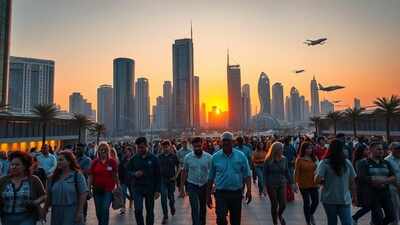The Gulf region is set to add nearly 7 million new jobs by 2025, marking a significant milestone in its ongoing economic transformation. This robust growth aligns with the Gulf Cooperation Council’s (GCC) vision to diversify economies, promote private sector development, and foster an inclusive and gender-balanced workforce.As per the GCC-Stat Labour Statistics 2024 report, the total workforce in GCC countries from 2020 to 2024 expanded from 28 million to about 34.9 million, registering a cumulative growth of 24.8 percent in just four years. This represents an annual employment growth rate of 5.7 percent in 2024 alone, one of the highest rates recorded recently. These figures come amid increased oil production following the easing of OPEC+ cuts and a resilient non-oil sector, which grew by 3.7 percent in 2024.Countries across the Gulf have implemented targeted labor reforms to sustain this job growth. Saudi Arabia, for example, connected Saudization targets directly to wage levels, incentivizing employment of nationals in the private sector. The UAE expanded its Emiratisation initiative, Nafis, to include small and medium enterprises (SMEs), opening up more pathways for local talent. Meanwhile, Bahrain introduced flexible work permits and wage support programs through Tamkeen, and Qatar reached 50 percent localization in its energy sector jobs. Oman integrated its Job Security Fund with national social protection frameworks, reinforcing worker benefits.
Female workforce grows 11.6% in GCC
Female participation in the Gulf workforce has seen a historic rise. In 2024, the Saudi Arabia’s General Authority for Statistics (GASTAT) published the Labor Market Publication for Q3 which reveals between 2020 and 2024, female employment grew by 11.6 percent – from 2.8 million to 3.1 million, marking the fastest growth among all workforce segments. Within the Gulf national workforce, the number of female nationals grew by 3.4 percent from 2.2 million in 2023 to 2.3 million in 2024. Women now comprise 42 percent of new hires and 33 percent of the workforce at leading companies, though fewer than 28 percent advance to senior leadership roles.The gender imbalance in the Gulf workforce partly stems from demographic patterns. According to Global Insights data, women make up only 36.2 percent of the UAE’s population and about 37.2 percent across the broader GCC, with the rest largely men due to reliance on male-dominated migrant labor in sectors like construction and logistics. Despite this, governments are intensifying efforts to integrate more women into fast-growing sectors such as technology, renewable energy, and finance.
Future of working in the Gulf
The Gulf’s labor market is evolving rapidly, driven by economic diversification, labor reforms, and changing workplace culture. Strategic investments in education and skill development are expanding opportunities for both men and women in new and emerging fields such as artificial intelligence, cybersecurity, fintech, and green energy. The region’s leadership in embedding gender inclusivity and entrepreneurship within economic agendas is being touted as a model for sustainable growth and prosperity.As the Gulf looks toward 2025 and beyond, adding 7 million jobs alongside enhancing workforce diversity represents a transformative leap towards a balanced, inclusive economy – one where opportunities are accessible irrespective of gender, contributing to a resilient and future-ready Gulf economy.This remarkable labor market turnaround reflects not only quantitative job gains but also qualitative improvements in workforce inclusivity, signaling a new chapter for the Gulf’s socio-economic landscape. Go to Source


